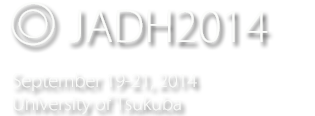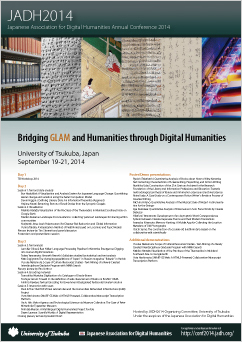Poster session 7
Memory Hunting: A Mobile App for Collecting the Location Metadata of Old Photographs
- Asanobu Kitamoto (National Institute of Informatics)
The minimum requirement of using old photographs for reconstructing historical landscape is the availability of proper metadata about locations, such as the location that the photograph was created (the location of the camera), or the location shown in the photograph (the location of the target). A photograph sometimes comes with a caption that suggests the content of the photograph, but textual description usually describes a place name whose vagueness limits the precision of geographic analysis in comparison to today's geotags measured by devices such as GPS. To find the precise location of the photograph, a basic strategy is to go to the site and compare the present landscape with the past landscape recorded in the photograph. The best match between two landscapes suggests the place that the photograph was taken, but this task requires a “mental transformation of landscape” in our brain so that a 2D old photograph is mapped into a 3D landscape by virtually rotating, scaling, and projecting the image, which is not easy to perform.
Instead, we propose a simple solution; namely, creating a mobile app to show an old photograph as an overlay on the viewfinder of the camera so that two landscapes can be directly compared. At the best match, pressing the shutter button triggers the recording of location metadata through the GPS of the device with a capture of the present landscape. Photographs and metadata are then uploaded to the server to allow the comparison of landscapes between the present and the past. This workflow is realized on our mobile app, “Memory Hunting,” to be used on either smart phones or tablets.
Here, comparison with “augmented reality” (AR) helps understanding the feature of the app. First, AR shows information (such as old photographs) as an overlay in the real space to enhance the interpretation of the present landscape. On the other hand, our app uses the present landscape to enhance the interpretation of old photographs, which can be regarded as “augmented photography” (AP). Second, AP can be used as a preparation step for AR, because the app can record metadata about the location and the direction of the camera. This metadata can be directly incorporated into AR, so Memory Hunting can be considered as a complementary tool to AR.
A by-product of this app is the natural introduction of a “gamification” mechanism. The app transforms the task of finding the location into the task of finding the best match between two landscapes. The latter has a clearly-defined goal that can be achieved by iteratively moving the camera to improve the goodness-of-match, and this task can give the sense of fun for users. It is expected that the sense of game may help expand the style and domain of activities based on this app. First, the style of activities can be expanded from team work to crowd-sourcing, where people enjoy taking pictures and providing location metadata at the same time. Second, the domain of activities can be expanded from historical studies to other domains such as tourism, where people enjoy walking around the town for scouting the location that photographs were taken, like a quiz.
The first version of the app was tested by the author at Tokyo and Kyoto in April 2014, using an Android smart phone. The result was promising. First, the comparison of two landscapes was significantly easier on the viewfinder than in the brain. Second, the author felt that finding the best match is not a given task but a task he would like to perform well. Moving back and forth at the site to find the best match was a trial worth spending some time. On the other hand, the author felt frustration on the limitation of the camera, especially when the best match could not be achieved due to a different angle of the lens. This problem is difficult to solve due to the limited feature of the camera on smart devices, and the lack of standard libraries to control various types of camera on Android OS. The author suggests that these problems are the largest obstacles to expand the user base of the app.
We will release the second version of the app on Google Play in the near future so that people can download it for free and use it for their own projects. Our goal is to make a convenient tool so that digital humanists can use it in their field study using their own smart devices.
- Acknowledgment
- The project was supported by Center for Integrated Area Studies, Kyoto University. The app was developed by a software engineer, Mr. Tomohiro Ikezaki.
- Keywords
- mobile app, old photograph, location metadata, augmented photography, gamification

